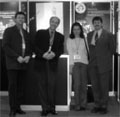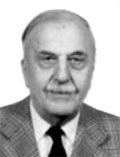The eLitMed.hu medical portal uses computer cookies for convenient operation. Detailed information can be found in the Cookie-policy.
Hungarian Radiology - 2003;77(02)
Content
[Metal objects in the MR]
[During magnetic resonance imaging the patient is exposed to three different types of electromagnetic radiation: static magnetic field, gradient or time varying magnetic fields and radiofrequency electromagnetic fields. The potential risks associated with performing MRI in patients with ferromagnetic implants, materials, or devices are related to the possibility of movement or dislodgement, to the induction of electrical currents and to the heating. The majority of metallic implants are considered to be safe for MRI, but patients with cardiac pacemakers, ferromagnetic aneurysm clips, cochlear implants, implantable drug infusion pumps should not be examined by MRI.]
[Treatment of ureter stenosis of the transplanted kidney using invasive radiological methods]
[INTRODUCTION - Stenosis, occlusion and necrosis of the ureter after kidney transplantation occur in 2-13%. The therapeutic choices are surgery or minimally invasive endourological and percutaneous procedures. We analysed our therapeutic plan and results using percutaneous dilatation and stenting. PATIENTS AND METHODS - The patients after kidney transplantation are regularly examined by ultrasound. In cases of suspected obstruction we perform scintigraphy and CT-urography, and if indicated, we place percutaneous nephrostomy. Between July of 2000 and September of 2002, 15 stenosis in 14 patients were dilated and stented percutaneously. RESULTS - We found one restenosis after 6 months due to compression. This patient underwent surgery, but after the operation another stenosis has developed. We treated it percutaneously. One nephrectomy had to be performed due to serious infection. In one patient stent migration occured and surgical intervention was performed. 12 patients have free urine passage and good kidney function as a result of percutaneous therapy. CONCLUSION - We have good results with percutaneous ureter dilatation and stenting, but our follow-up time (31 months) must be longer for the evaluation of long-term results. The percutaneous treatment can partly replace endourological and surgical methods or can be combined with each other.]
[The role of the mechanical lithotripsy for the treatment of ”difficult” common bile duct stones]
[INTRODUCTION - Present work aimed to identify some predictors of success or failure (gender, age, number and size of stones, presence of periampullary diverticula and jaundice) in mechanical lithotripsy. PATIENTS AND METHODS - 7998 endoscopic retrograde cholangio-pancreatographies, 2430 endoscopic sphincterotomies and 1205 bile duct stone extractions were performed between 1981 and 2000 years. In 159 patients - because of failure of standard techniques - mechanical lithotripsy was attempted for crushing of large bile duct stones. There were 39 men (mean age 70.5 years) and 120 women (mean age 67.7 years). 65 patients had single stone, 31 had 2 stones and 63 had multiple stones. 80 patients had larger stones than 20 mm in diameter. 23 patients had periampullary diverticula and 98 were jaundiced. Mechanical lithotripsy was accomplished with Olympus BML 2Q and BML 4Q intraendoscopic systems. When the first attempt failed, repeated treatment was performed or a Wilson-Cook extraendoscopic system was used. Data of predictors were processed using univariate analysis, Chi-square test and Fischer’s exact test. P<0.05 was regarded as statistically significant. RESULTS - Clearance of common bile duct was obtained in 130 patients (81.8%). Procedure related cholangitis occured in 16 patients. 8 pancreatitis developed, 7 of them subsided with conservative therapy, 1 of them required surgical treatment. On univariate analysis, the stone size was the only variable to differentiate the success from failure of procedure (p<0.05). Other variables had not any role in determining the outcome. CONCLUSION - Mechanical lithotripsy is a useful method with a high success rate and with an acceptable complication rate for treatment of ”difficult” bile duct stones. Stone size is the single outcome predictor.]
1.
Clinical Neuroscience
[Headache registry in Szeged: Experiences regarding to migraine patients]2.
Clinical Neuroscience
[The new target population of stroke awareness campaign: Kindergarten students ]3.
Clinical Neuroscience
Is there any difference in mortality rates of atrial fibrillation detected before or after ischemic stroke?4.
Clinical Neuroscience
Factors influencing the level of stigma in Parkinson’s disease in western Turkey5.
Clinical Neuroscience
[The effects of demographic and clinical factors on the severity of poststroke aphasia]1.
2.
Clinical Oncology
[Pancreatic cancer: ESMO Clinical Practice Guideline for diagnosis, treatment and follow-up]3.
Clinical Oncology
[Pharmacovigilance landscape – Lessons from the past and opportunities for future]4.
5.















